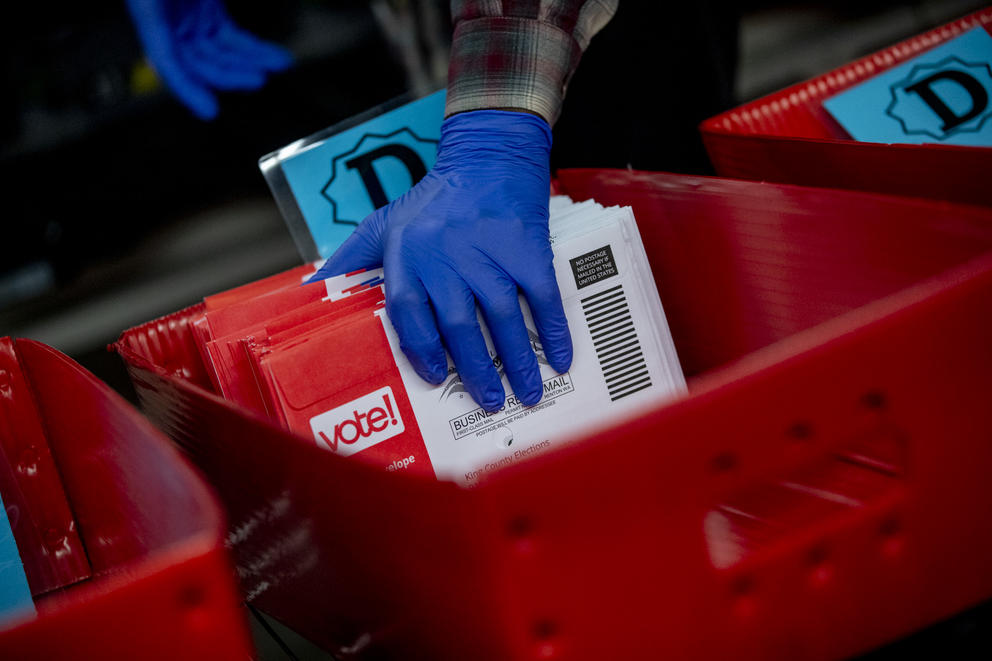The gaps among ethnic groups are smaller and also more difficult to track, as voters are not asked to supply their race when they register to vote; this data is tracked mostly by identifying people by their last names or by their geographic location.
Hispanic and Asian voters had ballots rejected at twice the rate of white voters in the 2020 election (1.3% and 1.2% vs. 0.6%). Black voters experienced ballot rejections in the 2020 election at about 50% higher than white voters (0.9% vs. 0.6%).
The good news: Most rejected ballots are “cured” in time to have those votes counted, according to the report released days before this year’s general election. And as UW professor Scott Allard, co-lead researcher on the study from the Evans Policy Innovation Collaborative, points out: Almost every ballot does get counted.
“Roughly 98% to 99% of all ballots in any county are signed, signature-matched and arrive on time,” Allard said, listing the three most common reasons ballots are rejected. He believes the state can do more to help voters close these gaps, including clearer communication on ballot envelopes, more standardized ballot processing across the state and improved voter outreach.
“I was really surprised by the cure rates,” Allard added. “Sixty percent with a signature challenge are cured by the time that election’s results are certified. That’s a really good percentage.”
More Washington ballots are rejected because people turn them in late than for any other reason. Lateness includes popping it in a mailbox with irregular pickup times or screeching to a halt in front of the drop box at 8:01 p.m.
But most of the ballot rejections for younger voters are because of signature issues, according to the report.
Allard has four pieces of advice for voters: Turn in your ballot a week before the election to give the elections office plenty of time to contact you if something doesn’t look right (and include contact information on your envelope). Don’t forget to sign the envelope for signature-match checking (one in eight rejected ballots don’t have a signature). Sign your ballot in the same way you signed your driver’s license. And check back at votewa.gov after you turn in your ballot to make sure it has been processed.
Most voters interviewed as part of the study did not realize that ballot envelope signatures were being compared to driver’s license signatures. And even those who did know this noted that signatures often change a lot over the years.
As one voter interviewed said, “It didn’t match what I have on my driver’s license, which is back from when I was 16 and didn’t know what my signature would be. So I just wrote my name down.”
Some noted that the way they signed their driver’s license is different from the way they sign every day on credit card receipts, for example. It doesn’t occur to most people which of those signatures need to be used on the outside of the ballot envelope, county elections officials agreed.
Only a small percentage of ballot envelopes are not signed, and the study found several statistically significant differences across voter demographic sub-groups for this situation. Most notable: Voters age 18 to 25 are more likely to not sign their ballot envelopes than older voters. Hispanic and Asian voters are slightly more likely to not sign than white or Black voters.
For the state, the study advises more attention to ballot envelope design: Make the text easier to read; use visual clues to emphasize important information; make the layout clearer, including space between sections; and make sure the information is where voters will find it. Their ideas include bold information reminding people when their ballots are due and a highlighted signature section. Signage on ballot drop boxes reminding people to sign their ballots might help as well.
The researchers also want the state to work more closely with community organizations to encourage people to return their ballots earlier, which could both fix the late-ballot problem and give people more time to “cure their ballot” if their envelope signature doesn’t match their driver’s license.
Allard said the researchers discovered something interesting happened in 2020 compared to other elections.
“In most elections, anywhere from 25 to 50% of ballots arrive late. In 2020, under 10% of ballots were late. That matters. That means the rate of rejection is lower,” in part because there was more time for people to fix signature problems if they occurred, he said.
The study was done at the request of the Secretary of State’s Office and the Washington Legislature, and was funded in part by the state budget. In addition to studying state data on ballot rejections, the UW researchers also interviewed voters about their experience with elections officials over rejected ballots, and conducted a survey of voters whose ballots had been rejected during the 2022 general election.
They also spoke with elections officials across the state and found significant differences in the resources available to oversee elections and process ballots. They also found variability in voter outreach and education. All these factors can contribute to uneven rates of ballot rejections and “curing.” The researchers recommend more statewide standardization of voting systems.
“King County is doing all kinds of interesting things to try to reduce rejection rates and increase cure rates,” Allard said. The researchers recommend the state learn from success stories like King County’s and do things to improve the voting experience statewide — for example, some places are inviting voters to update their signatures outside of the election cycle.



